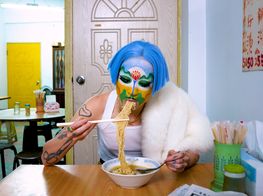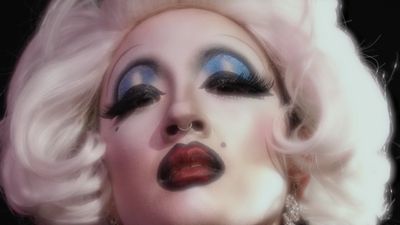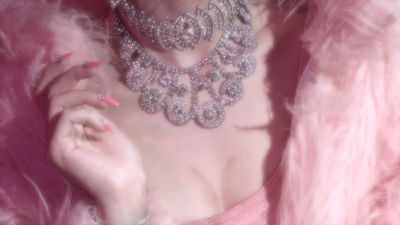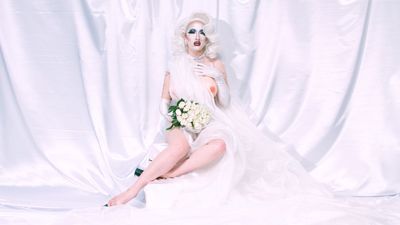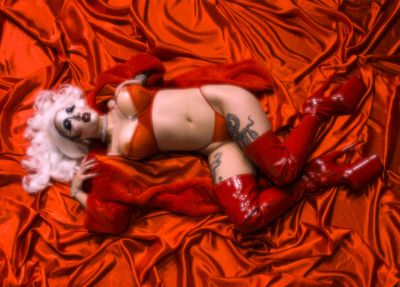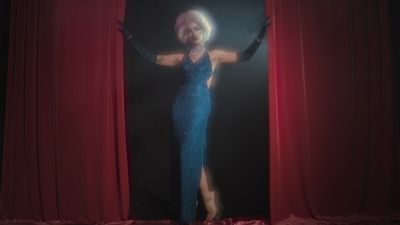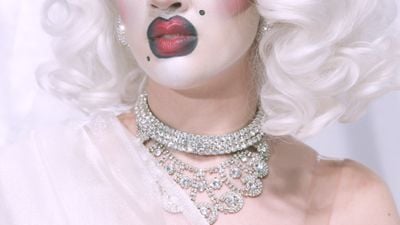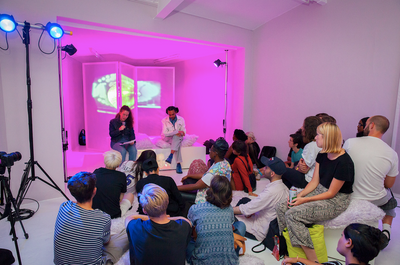Sin Wai Kin in Conversation
Victoria Sin, The sky as an image, an image as a net (2018). Performance at Park Nights 2018, Serpentine Galleries, London (13 July 2018). Courtesy the artist and Serpentine Galleries. Photo: Lewis Ronald.

Victoria Sin, The sky as an image, an image as a net (2018). Performance at Park Nights 2018, Serpentine Galleries, London (13 July 2018). Courtesy the artist and Serpentine Galleries. Photo: Lewis Ronald.
If a multiplicity of being can be truly embodied, Sin Wai Kin comes close. Sin's practice spans performance, moving image and writing, with the artist adopting personas in their work that are multiple, and thematics that are intersectional.
With a master's in Print from the Royal College of Art, a programme that examines the digital circulation of the image and its multitude of connotations, Sin's work focuses on speculative ideas surrounding the body, gender, and methods of decolonisation, using drag as a means of engagement.
To say Sin dresses in drag is an understatement. Rather, they embody drag's complex histories in order to embody transformation itself. Whether in performances staged at art institutions around the world, including the Taipei Contemporary Art Center and London's Institute of Contemporary Art, or in documentation published on their Instagram account, Sin's sensual use of clothing and makeup—face powder, fake eyelashes, exaggerated bow lips, giant silicone breasts, and pewter wigs—creates a layer of separation from the viewer.
Erotic poses become serious parodies: a formal manifestation of the construction of gender and cultural identity. Irresistible images force the viewer to look, then re-look, until they are left looking at themselves; something that comes across in their current show at Sotheby's S|2, Narrative Reflections on Looking (23 November 2018–25 January 2019), for which a series of short film works narrate fantasy meetings in a lush, low voice.
Sin describes their use of science fiction in both performance and writing as 'a practice of rewriting patriarchal and colonial narratives naturalised by scientific and historical discourses on states of sexed, gendered and raced bodies'. Their ongoing project Dream Babes, first staged in collaboration with Auto Italia South East (2016) and now an independent project funded by Live Art UK, involves reading groups, a zine, and a live programme exploring 'science and speculative fiction as a productive strategy of queer resistance, imaging futurity that does not depend on existing historical and social infrastructure.'
A lot of drag is about unlearning for me, but it's also creating new models of gender and identity.
Dream Babes invites participants to enter a zone where bodies are amorphous and images are not easily readable. Throughout, ideas unravel slowly through discourse, while paying tribute to the Afrofuturists and Cyberfeminists, whose interpretations of space produced radical and welcoming sites for alienated bodies.
In performance and in writing, Sin's references to their Asian background displace the physical, social, and technological body; re-organising experience so that the voices of the absurd, forgotten, and silenced are heightened, given revised focus, and seen in a new light. These references are made explicit in the artist's upcoming performance in Taipei, If I had the words to tell you we wouldn't be here now (2019), which will be staged on 16 January as part of Su Misu's solo exhibition at Chi-Wen Gallery, I am a fake but my heart is true, Part II (12 January–28 February 2019). The intervention questions the role of language in the reproduction of identity categories through an engagement with the Cantonese opera VHS tapes that they listened to as a child with their grandmother, in which female actors would play both halves of a romantic couple.
There is, of course, a concrete vision that underlies Sin's projects, as expressed in the artist's upcoming show with Sophia Al-Maria at Whitechapel Gallery in London, BCE (15 January–28 April 2019). In a new film collaboration, Al-Maria invited Sin to write and perform an apocalyptic creation myth to camera that is hopeful for a better future; something Sin discusses in this conversation, among other projects.
HSSLet's begin with poetry. How do you use words to construct your performance personas, and how do you think language functions in the politics of drag?
VSThe first narratives in my work came from looking at some experimental footage I had shot of my drag persona in the RCA Moving Image Studio for several weeks. At some point something clicked, and I wrote something which connected the experience of looking at images of my drag character, and the experience of looking at ideal images of girls and women in teen magazines as a preteen. Both are experiences of looking at constructed ideal images; and by anthropomorphising constructed ideal images in poetry and narratives, I am better able to describe the way that our relationships to them change and change us.
Language and voice are very present in drag. Drag queens are often expected to embody the voice of someone else through lip-syncing or to embody the voice of the queer community. I often use the device of lip-syncing to challenge the positionality of the voice speaking, the performer, and the image being spoken about. The positionality is meant to be fluid, as I think language used to describe identity should be. Humans have constructed identities through language in order to try to understand them as static and clearly delineated, when in fact they are not. The challenge is trying to use language to describe something which is always transforming.
HSSI like the idea that poetry may contain an inherent fluidity, in that it is infinitely interpretable via metaphor. One of the most intriguing aspects of your practice is the way you title your works: they're long, seductive, and they resist hierarchies and definitions. Let's talk about your early drag persona and how it has evolved to grapple with the joy and alienation of both the history of drag and transgender politics now?
VSTitles are important. They can be little works in themselves, they can add an unexpected layer to a work, and also act as a way in. My titles often include clues and references. For example, the title of my film which was recently in the Hayward Gallery's DRAG exhibition, Tell me everything you saw, and what you think it means (2018) is a direct quote from Grace Kelly in Hitchcock's Rear Window. It plays on the way the film deals with the ethics of voyeurism, and the fact that within it Grace Kelly is the real object of the gaze.
My recent performance for the Serpentine Galleries' Park Nights 2018 programme, The sky as an image, an image as a net (2018) speaks to our relationship with images. A blue sky is the result of molecules in the air scattering blue light from the sun more than red light, and that light is so intense that it obstructs stars and everything else we can see at night. Stars and the dark expanse they sit in remind us of our minuscule place in a possibly infinite universe, and the possibilities within it. In the same way, within an image-based culture, images we are bombarded with every day—which represent and reify cultural constructs like gender—prevent us from seeing past pre-existing categories.
My drag character is directly related to this because it's an attempt at an ideal image of Western femininity, one which has been fed to me in this image-based culture. It's an image I have consciously and unconsciously strived towards my whole life, and which has affected the way that I relate to myself and to others. A lot of drag is about unlearning for me, but it's also creating new models of gender and identity. It's always been a speculative space. I've had friends who have come out as trans after experimenting with drag, and it was through drag that I realised I wasn't a woman. This unlearning and rewriting of my identity has allowed me to see myself and my relationships in ways I could never have previously imagined.
HSSCould you talk about your background and how the 'unlearning' you refer to within your drag persona has informed your national/anti-national/cultural identity? How will these ideas inform your performance in Taipei as part of Su Misu's solo exhibition at Chi-Wen Gallery?
VSThe unlearning has as much to do with race as it has to do with gender. As a mixed-race person of colour growing up in a Western society, I've been through a lot of phases in my relationship to whiteness. Growing up I wanted to be white. I remember telling my mother that I would never be beautiful because I didn't have blonde hair and blue eyes like she did. She was of course horrified, but that really was something I thought based on the culture that I lived in and the narratives and images that surrounded me.
Following that there was a phase of not wanting to be white at all, and feeling ashamed at being closely related to people who were white and had racist attitudes, working through my relationships to them at the same time as trying to recognise those attitudes which I had inherited. To be honest, working through relationships and the attitudes inherited from the people that raised you and the culture you live in never ends—it's an ongoing process, as tackling racism in a society built on white supremacy should be. Drag is a safe place for me to act on my desire and take pleasure in embodying things that the culture I'm present in has always told me I want to be, while at the same time presenting them as a fallacy, a goal with no end except control.
Like, yes it's all fake but so what? I'm still breathtaking, and what's real anyways?
In terms of nationalism, I have always been asked 'where are you from?' and the answer people want is never Canada, where I lived until I was 18, or London, where I've lived since. I have never felt especially connected or loyal to a country, though I have always had the immense privilege of having citizenship. All of this is to say that identity is incredibly complex, and my work is where I can take my experience of it and image it in the ways I can see it, only transformed through fantasy and theatrical devices.
My new performance for Chi-Wen Gallery in Taipei, If I had the words to tell you we wouldn't be here now, will be presented in their beautiful garden on 16 January, in the run-up to Taipei Dangdai [18–20 January 2019]. I'll be working with Taiwanese pipa player Peiju Lien, in order to bring in a sense of the auditory landscape that I grew up with watching my grandmother's Cantonese opera tapes as a child—though the way Peiju plays the instrument is much more contemporary, and in this case, Taiwanese rather than Chinese. These tapes often featured female actors playing romantic lead roles opposite each other—one would play a man and one would play a woman. I'm finding the narratives that have always been present in my life which have gone ignored, and questioning the role language plays in the reproduction of identity categories.
HSSIt's funny—I felt the same way growing up in India. There were advertisements for skin lightening creams everywhere. Today, when I video call my grandma, she tells me I look 'nice' when I look fair and 'tired' when I have a tan!
VSYes, my grandmother does the same.
HSSStill, sometimes the past feels so discriminatory, and sometimes it feels much more radical. Again, in India, we've had a third gender since forever, yet homosexuality was only recently decriminalised.
VSYes, that may also be a complex thing where laws against homosexuality, and erased queer histories, are wrapped up in histories of colonialism. I think probably it's been back and forth across intertwining histories of phobia, acceptance, and even celebration—more times than we can imagine.
HSSI was struck by the films at Sotheby's and their heightened theatricality. The hyperbolic 'she', the dry ice, the poetry, the proximity. Do you want to talk a little about your formal choices and the work they do?
VSThe work at Sotheby's is a body of work called Narrative Reflections on Looking (2016–2017), it's four films on desire in the experience of identifying with images. The films' narratives all come from really personal experiences of looking and wanting, which have been slightly abstracted with a lens of fantasy or science fiction. The films use the medium to tap into the language of cinema; to highlight how technologies of representation—such as cinema or any images on screens, or magazines or any popular media—create and reify the identity categories and ideals they represent. They were all filmed on 4k, which allows you to get these highly detailed closeups.
The thing about drag is that you often create a fantasy on stage, but when you look closely you can see the fallacy—that the diamonds are fake, that the glamorous hair is an old wig, that the eyelashes are falling off a little. Making these films allowed me to give the fantasy and at the same time show how heavily it is constructed in a way that does not undermine it. Like, yes it's all fake but so what? I'm still breathtaking, and what's real anyways?
HSSCould you tell me about your upcoming collaboration with Sophia Al-Maria at Whitechapel Gallery?
VSThe work at Whitechapel Gallery will be very exciting. Sophia asked me to write a creation myth for the show, which I have re-imagined as an apocalypse myth. The work is heavily influenced by Ursula le Guin's The Carrier Bag Theory of Fiction, which emphasises the power of stories, and the importance of stories which hold many perspectives and many ideas together. It is also influenced by Octavia Butler and her Earthseed books in which 'God is Change', because the only thing that is for certain is that everything will change, and that is a future we should be ready for.
HSSIn your ongoing project Dream Babes, you talk about sci-fi as a strategy for queer resistance. Tell me more? Where is it headed?
VSDream Babes is very much influenced by Afrofuturism and Cyberfeminism. My main influences in the project have been important figures in both these movements: Samuel Delany, Ursula le Guin, Octavia Butler, Donna Haraway. Delany, Le Guin, and Butler are the most read in the project's reading group, and in my own personal reading. These are authors who showed me what it was like to live in societies where non-binary gender is the norm, or that are self-governed and non-hierarchical.
The power of science fiction is world-making. You can create a whole new model for society that does not depend on current socio-political infrastructure, or you can make a world that shows us the dire projected future of our own socio-political system. Or you can make a world that speaks more incisively about our own world than non-fiction ever could, using aliens and galaxies instead of nationalism, race, or gender. Each of these can be incredible, mind altering, and powerful devices. The next step for Dream Babes will be a sequel to our last Speculative Futures Zine published with PSS, where I ask various practitioners to contribute texts, images, or poems that do the work of world-making from much-needed intersectional perspectives. —[O]

